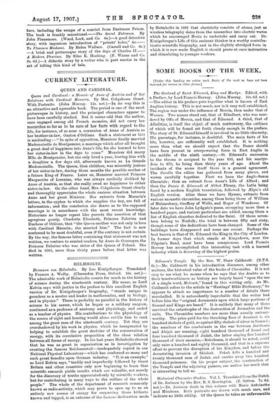SOME BOOKS OF THE WEEK.
[Under this heading we notice such Books of the week as have not been reserved for review in other forms.]
The Garland of Saint Edmund, King and Martyr. Edited, with a Preface, by Lord Francis Hervey. (John Murray. 10s. 6d. net.) —The editor in his preface puts together what is known of East Anglian history. This is not much, nor is it very well established. The region was under the influence of Mercia, then under that of Wessex. Two names stand out, that of Ethelbert, who was mur- dered by Offa of Mercia, and that of Edmund. A third, that of Athelstan, is itself the object of much controversy, the outlines of which will be found set forth clearly enough in the preface. The story of St. Edmund himself is involved in no little obscurity. His parentage, for instance, is doubtful. The main facts of his life, however, are sufficiently well established. It is nothing more than what we should expect that the Danes should have been present in overpowering force in East Anglia in the middle of the ninth century,—St. Edmund's succession to the throne is assigned to the year 855, and his martyr- dom to 870, he being then thirty years of age. About the incidents of the scene itself there is a general agreement. The Corolla the editor has gathered from many places, and woven carefully together. First we have the Anglo-Saxon Chronicle ; then an extract from Asser's Life of Alfred ; and then the Passio S. Edtnundi of Abbot Fleury, the Latin being faced by a modern English translation, followed by lElpie's old English version. After these we have Hymns, extracts from various monastic chronicles, among them being those of William of Malmnesbury, Geoffrey of Wells, and Roger of Wendover. Of later date we have John Lydgate's poem, occupying more than a hundred pages, and various particulars are added, among them a list of English churches dedicated to the Saint. Of these seven- teen belong to Norfolk; the total is between fifty and sixty, though some of the dedications have been changed. Some of the buildings have disappeared and some are recent. Perhaps the best known is that of St. Edmund the King in the City of London. In former days that which stands at Kingsdown, near the Pilgrim's Road, must have been conspicuous. Lord Francis Hervey has accomplished this interesting task with a learned industry which is deserving of the highest praise.


































 Previous page
Previous page